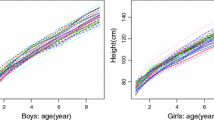Abstract
We propose here a novel functional inverse regression method (i.e., functional surrogate assisted slicing) for functional data with binary responses. Previously developed method (e.g., functional sliced inverse regression) can detect no more than one direction in the functional sufficient dimension reduction subspace. In contrast, the proposed new method can detect multiple directions. The population properties of the proposed method is established. Furthermore, we propose a new method to estimate the functional central space which do not need the inverse of the covariance operator. To practically determine the structure dimension of the functional sufficient dimension reduction subspace, a modified Bayesian information criterion method is proposed. Numerical studies based on both simulated and real data sets are presented.



Similar content being viewed by others
References
Amato U, Antoniadis A, Feis ID (2006) Dimension reduction in functional regression with applications. Comput Stat Data Anal 50:2422–2446
Bosq D (1991) Modelization, non-parametric estimation and prediction for continuous time processes. In: Roussas G (ed) Nonparametric functional estimation and related topics, NATO, ASI Series, pp 509–529
Carroll R, Li KC (1995) Binary regression in dimension reduction models: a new look at treatment comparisons. Stat Sin 5:667–688
Carey J, Liedo P, Müller HG, Wang JL, Chiou JM (1998a) Relation of age patters of fecundity to mortality, longevity and lifetime reproduction in a large cohort of Mediterranean fruit fly females. J Gerontol Biol Sci 53:245–251
Carey JR, Liedo P, Müller HG, Wang JL, Vaupel JW (1998b) Dual modes of aging in Mediterranean fruit fly females. Science 281:996–998
Cook RD (1998a) Principal Hessian directions revisited. J Am Stat Assoc 93:84–94
Cook RD (1998b) Regression graphics. Wiley, New York
Cook RD, Lee H (1999) Dimension reduction in binary response regression. J Am Stat Assoc 94:1187–1200
Cook RD, Weisberg S (1991) Discussion of “sliced inverse regression for dimension reduction”. J Am Stat Assoc 86:28–33
Cook RD, Li B, Chiaromonte F (2007) Dimension reduction in regression without matrix inversion. Biomatrika 94:569–584
Dauxois J, Ferré L, Yao AF (2001) Un mod\(\grave{e}\)semi-paramétrique pour variable aléatoire hilberienne. C. R. Accad. Sci. Pairs t. 327 série I, pp 947–952
Delaigle A, Hall P (2012) Methodology and theory for partial least squares applied to functional data. Ann Stat 40:322–352
Ferraty F, Vieu P (2006) Nonparametric functional data analysis: theory and practice. Springer, New York
Ferré L, Yao AF (2003) Functional sliced inverse regression analysis. Statistics 37:475–488
Ferré L, Yao AF (2005) Smoothed functional inverse regression. Stat Sin 15:665–683
Hall P, Müller HG, Wang JL (2006) Properties of principal component methods for functional and longitudinal data analysis. Ann Stat 34:1493–1517
Horváth L, Kokoszka P (2012) Inference for functional data with applications. Springer, New York
Hsing T, Ren H (2009) An RKHS formulation of the inverse regression dimension reduction problem. Ann Stat 37:726–755
Li KC (1991) Sliced inverse regression for dimension reduction (with discussion). J Am Stat Assoc 86:316–342
Lian H, Li GR (2014) Series expansion for functional sufficient dimension reduction. J Multivar Anal 124:150–165
Müller HG, Stadtmüller U (2005) Generalized functional linear models. Ann Stat 33:774–805
Müller HG, Chiou JM, Carey JR, Wang JL (2002) Fertility and life span: late children enhance female longevity. J Gerontol 57:202–206
Partridge L, Harvey PH (1985) Costs of reproduction. Nature 316:20–21
Ramsay JO, Silverman BW (2005) Functional Data Analysis, 2nd edn. Springer, New York
Riesz F, Nagy B (1955) Functional analysis. Ungar, New York
Wang GC, Lin N, Zhang BX (2013) Dimension reduction in functional regression using mixed data canonical correlation analysis. Stat Interface 6:187–196
Wang GC, Zhou Y, Feng XN, Zhang BX (2015) The hybrid method of FSIR and FSAVE for functional effective dimension reduction. Comput Stat Data Anal 91:64–77
Wang GC, Zhou JJ, Wu WQ, Chen M (2017) Robust functional sliced inverse regression. Stat Papers 58:227–245
Yao F, M\(\ddot{u}\)ller HG, Wang JL, (2005) Functional data analysis for sparse longitudinal data. J Am Stat Assoc 100:577–590
Zhang JT, Chen JW (2007) Statistical inferences for functional data. Ann Stat 35:1052–1079
Zhu LX, Miao BQ, Peng H (2006) On sliced inverse regression with high-dimensional covariates. J Am Stat Assoc 101:630–643
Acknowledgements
The authors are very thankful to the Editor, Associate Editor, and a reviewer for their constructive comments and suggestions, which have helped significantly in improving the paper. Guochang Wang’s research was supported by NSFC 11501248 from the National Science Foundation of China and from the Fundamental Research Funds for the Central Universities, Baoxue Zhang’s research was supported by NSFC 11671268 from the National Science Foundation of China.
Author information
Authors and Affiliations
Corresponding author
Additional information
Publisher's Note
Springer Nature remains neutral with regard to jurisdictional claims in published maps and institutional affiliations.
Electronic supplementary material
Below is the link to the electronic supplementary material.
Appendix
Appendix
1.1 Proof the Theorem 3.1
Let K be the true value of the dimensionality of \(S_{y|x}\). By the law of large number, we have \(\hat{\varGamma }_e-\varGamma _e=O_p(1/\sqrt{n})\). And the Theorem 2.7 of Horváth and Kokoszka (2012), we can get
Therefore, If \(\hat{K}>K,\)
If \(\hat{K}<K\),
It follows from (9) and (10) that \(\hat{K}\rightarrow K\) in probability.
Rights and permissions
About this article
Cite this article
Wang, G., Liang, B., Wang, H. et al. Dimension reduction for functional regression with a binary response. Stat Papers 62, 193–208 (2021). https://doi.org/10.1007/s00362-019-01083-1
Received:
Revised:
Published:
Issue Date:
DOI: https://doi.org/10.1007/s00362-019-01083-1



